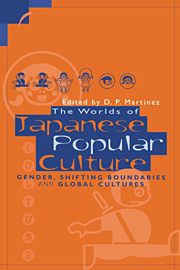Chapter 5 - Vampires, Psychic Girls, Flying Women and Sailor Scouts
Four faces of the young female in Japanese popular culture
Published online by Cambridge University Press: 22 September 2009
Summary
Introduction
Nowhere is the dizzying rate of change in post-war Japan more apparent than in the shifting and varied identities of the modern Japanese woman. Well into the 1960s, the average woman in her thirties was almost sure to be a housewife and a mother. Today, while this lifestyle is still widely chosen, the percentage of married women who work outside the home is actually higher than those who stayed home thirty years ago. In addition, an increasing percentage of women prefer to put off marriage or remain childless, or both. While many women still opt for traditional secretarial work, others, such as the new Crown Princess before her marriage, have opted for high powered and high pressure careers.
What role does popular culture play in relation to the enormous changes undergone by Japanese women over the last several decades? In fact it has played an important, and even an exciting one, functioning both to reflect these changes and to inspire them. Ranging in variety from the haha mono or “mother movies” of the 1950s to the “flying women” image used in ad campaigns in the 1980s, images of women in popular culture have served on the one hand to re-inscribe traditional roles into post-war Japanese society and, on the other, to offer visions of escape from them.
- Type
- Chapter
- Information
- The Worlds of Japanese Popular CultureGender, Shifting Boundaries and Global Cultures, pp. 91 - 109Publisher: Cambridge University PressPrint publication year: 1998
- 13
- Cited by

